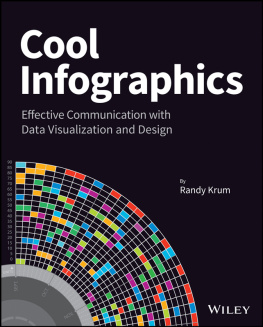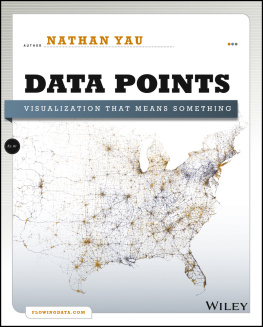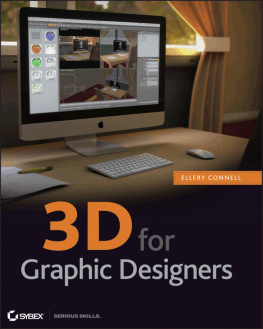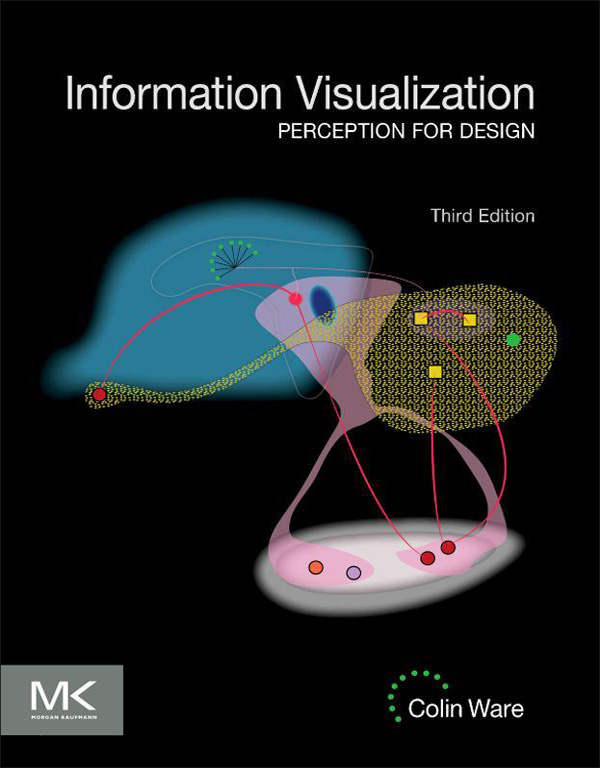Information Visualization
Perception for Design
Third Edition
Colin Ware

Acquiring Editor: Meg Dunkerley
Development Editor: Heather Scherer
Project Manager: Paul Gottehrer
Designer: Kristen Davis
Morgan Kaufmann is an imprint of Elsevier
225 Wyman Street, Waltham, MA 02451, USA
2013 Elsevier, Inc. All rights reserved.
No part of this publication may be reproduced or transmitted in any form or by any means, electronic or mechanical, including photocopying, recording, or any information storage and retrieval system, without permission in writing from the publisher. Details on how to seek permission, further information about the Publishers permissions policies and our arrangements with organizations such as the Copyright Clearance Center and the Copyright Licensing Agency, can be found at our website: www.elsevier.com/permissions.
This book and the individual contributions contained in it are protected under copyright by the Publisher (other than as may be noted herein).
Notices
Knowledge and best practice in this field are constantly changing. As new research and experience broaden our understanding, changes in research methods or professional practices, may become necessary. Practitioners and researchers must always rely on their own experience and knowledge in evaluating and using any information or methods described herein. In using such information or methods they should be mindful of their own safety and the safety of others, including parties for whom they have a professional responsibility.
To the fullest extent of the law, neither the Publisher nor the authors, contributors, or editors, assume any liability for any injury and/or damage to persons or property as a matter of products liability, negligence or otherwise, or from any use or operation of any methods, products, instructions, or ideas contained in the material herein.
Library of Congress Cataloging-in-Publication Data
Ware, Colin.
Information visualization : perception for design / Colin Ware. 3rd [edition].
pages cm (Interactive technologies)
Summary: This is a book about what the science of perception can tell us about visualization. There is a gold mine of information about how we see to be found in more than a century of work by vision researchers. The purpose of this book is to extract from that large body of research literature those design principles that apply to displaying information effectively Provided by publisher.
Includes bibliographical references and index.
ISBN 978-0-12-381464-7 (hardback)
1. Visual perception. 2. Visualization. 3. Information visualization. I. Title.
BF241.W34 2012
152.14dc23
2012009489
British Library Cataloguing-in-Publication Data
A catalogue record for this book is available from the British Library.
For information on all MK publications visit our website at www.mkp.com
Printed in China
12 13 14 15 16 10 9 8 7 6 5 4 3 2 1
Typeset by: diacriTech, Chennai, India

Preface
There are two major changes in this latest edition of Information Visualization: Perception for Design. The first is intended to make the design implications of research in perception clearer. To this end, 168 explicit guidelines for the design of visualizations have been added to the text in highlighted boxes. These guidelines should be taken as suggestions to support design decisions, not as hard and fast rules. Designing visualizations is a complex task, and it is not possible with a succinct guideline to set out all the circumstances under which a particular rule may apply. Graphic designers must take into account interactions between small symbols and large areas of color and texture as well as shading effects, shape effects, the grouping of symbols, and so on. Different tasks may dictate changes in what should be highlighted and what should be deemphasized. Often a designer must use an existing color scheme or symbol set, and this also constrains the design problem. Because of this complexity, it is important to understand the theory behind a guideline before it is applied; understanding the mechanisms of perception and the processes of visual thinking can make it clear when and how that guideline should be applied and when it does not apply.
The second major change is an increased emphasis on the process of visual thinking. The book now more fully incorporates the modern view that perception is an active process in which every part of the visual system is retuned several times a second to meet the needs of the current visual task. The greatest change is a radical reworking of the final chapter, which now sets out the key components of the architecture of the visual brain and follows this with a description of ten visual thinking algorithms. These describe how people think using common visualization tools and techniques. They are intended to help a designer take a visualization design problem and create a novel and well-designed visual thinking tool.
In addition to these major changes, the book has been revised and updated throughout to take recent research into account. Hundreds of new references have been added, and most of the figures have been redrawn to take advantage of full-color printing.
Now let me tell you how this book came about. In 1973, after I had completed my masters degree in the psychology of vision, I was frustrated with the overly focused academic way of studying perception. Inspired by the legacy of freedom that seemed to be in the air in the late 1960s and early 1970s, I decided to become an artist and explore perception in a very different way. But after three years with only very small success, I returned, chastened, to the academic fold, though with a broader outlook, a great respect for artists, and a growing interest in the relationship between the way we present information and the way we see. After obtaining a doctorate in the psychology of perception at the University of Toronto, I still did not know what to do next. I moved into computer science, via the University of Waterloo and another degree, and have been working on data visualization, in one way or another, ever since. In a way, this book is a direct result of my ongoing attempt to reconcile the scientific study of perception with the need to convey meaningful information. It is about art in the sense that form should follow function, and it is about science because the science of perception can tell us what kinds of patterns are most readily perceived.
Why should we be interested in visualization? Because the human visual system is a pattern seeker of enormous power and subtlety. The eye and the visual cortex of the brain form a massively parallel processor that provides the highest bandwidth channel into human cognitive centers. At higher levels of processing, perception and cognition are closely interrelated, which is the reason why the words understanding and seeing are synonymous. However, the visual system has its own rules. We can easily see patterns presented in certain ways, but if they are presented in other ways they become invisible. Thus, for example, the word









